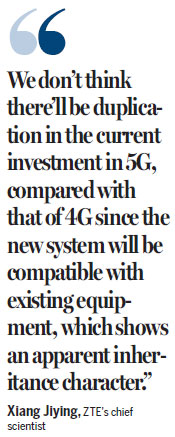Big drive toward 5G technology
Updated: 2015-03-26 07:22
By Gladdy Chu in Hong Kong(HK Edition)
|
|||||||
|
Mainland 5G vendors have to cooperate with European peers, which have a bigger say in the issue, to formulate a 5G standard, experts believe. Angel Navarrete / Bloomberg |
Mainland mobile-equipment makers and telecom operators are seeking to place themselves and their agendas in the driving seat of the next-generation mobile-telecom technology, 5G, not long after 4G entered the mainland market.
With three mobile carriers having won 4G licenses on the mainland in December 2013, industry experts are betting on an acceleration in information consumption on the mainland, and that a 500-billion yuan ($80.5 billion) market would gradually emerge in coming years.
Shenzhen-based ZTE Corp said it has teamed up with Germany's telecom-services provider Deutsche Telekom to develop 5G technology by launching an innovation lab.
"We don't think there'll be duplication in the current investment in 5G, compared with that of 4G since the new system will be compatible with existing equipment, which shows an apparent inheritance character," said ZTE's chief scientist Xiang Jiying.
The new technology, expected to roll out before 2020 at the earliest, would offer data transmitting speeds about 100 times faster than the existing 4G network, with a peak bit rate reaching 10 GB per second. This will enable subscribers to download a high definition movie in one second.
Apart from a super-fast mobile network, Nokia said in a paper on 5G use cases and requirements that a "zero latency gigabit experience" is equally important with the increase in data rates, which will drive evolution in various industries, such as the automotive, health and logistics and sectors.
The company pointed out that the term "zero latency" does not mean no data transmission delay at all - it simply represents the fact that 5G needs to deliver latencies low enough that the radio interface will not be the bottleneck, even for the most challenging use cases.
The 5G technology will surpass 4G with a stronger data capacity, more devices and higher reliability with lower costs and reduced latency, Nokia said.
"The advance will show 1,000 times in data throughput, an order of magnitude shorter in data transmission delay, and two orders of magnitude more in number of devices," Xiang said.

In the current stage of formulating the 5G standards, China Mobile (China), NTT Docomo (Japan) and KT (South Korea) said they would conduct three-way 5G technical collaboration to accelerate commercial deployment and drive standardization efforts.
Telecom equipment giants, including Huawei Technologies Co Ltd, Ericsson and Nokia Networks, also demonstrated technology that forms the basis of their 5G road maps at the recent Mobile World Congress held in Spain.
Huawei and ZTE almost simultaneously started their 5G deployments in 2009. In late 2013, Huawei announced its 5G manifesto to further invest a minimum of $600 million in research and development for 5G networks in five years. The company also joined the 5G Infrastructure Association to help formulate and implement a 5G communications plan with partners and to disseminate results at a global level.
The 5G Infrastructure Association represents the private party of the 5G Public-Private Partnership (5G-PPP) - a 1.4-billion-euro ($1.5 billion) joint initiative between the European Information and Communication Technology Industry and the European Commission, aimed at materializing the next generation of communication networks that will deliver super-fast connectivity for Europe and globally.
After having completed pre-commercial field testing of the world's first "pre-5G" base station in partnership with China Mobile earlier, ZTE also launched a "pre-5G" testing base station at the trade show in Spain. ZTE's "pre-5G" technology has increased the 4G network system capacity by four to five times, the commercial use of which will be possible in 2016, following tests and adjustment. ZTE said it will continue to deliver "pre-5G" features to offer 5G-like experience before 5G standardization.
"It's nearly impossible that only Chinese vendors or European vendors will formulate a 5G standard on their own," Xiang said. "We have to cooperate to get the work done, the same as 3GPP (the Third Generation Partnership Project) working out 3G and 4G standards."
The China Communications Standards Association is one of the seven 3GPP organizational partners from Asia, Europe and North America. However, Xiang said that, at present, the main threat to Chinese mainland vendors comes from European operators, which have a bigger say in 3GPP.
gladdy@chinadailyhk.com
(HK Edition 03/26/2015 page8)
